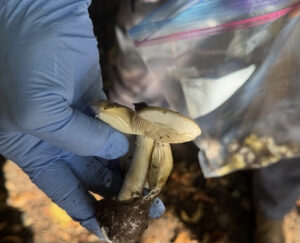Co-ordinators: (Tuesday and Thursday) Kathleen Martin
Rosemary Balfour, Dave Clark
The Woodlands is one of the last untouched Garry Oak meadows on southern Vancouver Island. The gardens, approximately 22 acres, or 2/3 of the property, lie behind and below the House.The best time to view the Woodlands is March to early June. An interpretive board at the trailhead provides restoration information, flora illustrations, and nine numbered trailside viewpoints, which include a rare trembling aspen grove.
The Woodlanders (as the volunteers call themselves) consider themselves stewards of this unique ecosystem. They have worked since 1991 to create a habitat for plants, birds, bees, and butterflies.To restore the native habitat, they remove invasive species and encourage native plants such as salal, sword ferns, Nootka rose, and Oregon grape.
Spring blooms range from satin-flowers, spring-gold and Indian plum’s dangling blossoms, followed by oak buds, white fawn lilies, purple-blue camas, shooting star, western buttercups, to ground orchids and delicate harvest broadiaea. Fall rains bring mosses and licorice ferns.
Not Your Benign Toadstools
Death Cap mushrooms (Amanita phalloides) are seriously poisonous and probably brought to North America on the roots of European tree species. They are showing up in Victoria, Vancouver, and American west coast states. Death Caps appear in many places on the Government House grounds, first emerging between late July through to November, and not always where they were the previous year.
 They are white with a gold-green sheen cap, white gills, and a skirt near the top of the stem. There is a bulb-like sack in the ground as part of the mushroom. A poster with photos of growth stages is posted near the main gate at Government House and in the Mews toolshed window.
They are white with a gold-green sheen cap, white gills, and a skirt near the top of the stem. There is a bulb-like sack in the ground as part of the mushroom. A poster with photos of growth stages is posted near the main gate at Government House and in the Mews toolshed window.
How to Get Rid of Them
Wear protective gloves to gather and dispose of them. Pick the mushroom and the sack-like cup under the soil. Put in a plastic bag and seal. Throw out the mushrooms, still sealed in the plastic bag, with your household garbage, not in the compost pile, and not in the green compost bin as this will only spread them. Wash hands thoroughly. If you think you have eaten them, phone the poison control centre at 1-800-567-8911 immediately.
Where the Wild Things Grow


The Princess Royal’s May visit coincided with the best time to see the Woodlands in all its glory. Volunteers were especially pleased at her positive comments about the area. Princess Anne also took photos of the camas and the Coronation Walkway from the Terraces. Woodlanders removed invasive species at the lookout to encourage the growth of native plants such as salal, sword ferns, Nootka rose, and Oregon grape. Volunteers were especially pleased at her positive comments about the area. Princess Anne also took photos of the camas and the Coronation Walkway from the Terraces.
Pathway Named in Honour of King Charles III

The trail has been improved to better withstand winter’s inclement weather. It is bordered by a split rail fence which will encourage visitors to protect the woodland ecosystem.

The trail has been improved to better withstand winter’s inclement weather. It is bordered by a split rail fence which will encourage visitors to protect the woodland ecosystem. Members were later treated to hot chocolate and pastries.
“King Charles III has been a strong champion of environmental causes long before they became an important focus for many of us,” says Patty Grant.

